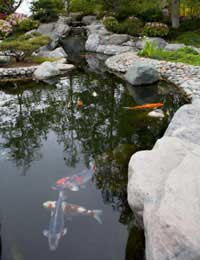 Although garden ponds are on the whole, safe places to be, it never does to become too complacent when it comes to possible dangers – however unlikely – particularly since so many accidents are preventable with just a bit of forethought. The potential threat to children is very well known – for the under-fives, drowning is the third most common cause of accidental death in the home and over 100 youngsters have died in this way over the last ten years – but the issue of general pond safety affects us all.
Although garden ponds are on the whole, safe places to be, it never does to become too complacent when it comes to possible dangers – however unlikely – particularly since so many accidents are preventable with just a bit of forethought. The potential threat to children is very well known – for the under-fives, drowning is the third most common cause of accidental death in the home and over 100 youngsters have died in this way over the last ten years – but the issue of general pond safety affects us all.
Don’t Fall In
The pond edge is one possible trouble spot. Poorly fixed or uneven paving slabs offer the perfect recipe for becoming rather more suddenly and intimately acquainted with pond-life than even the most avid wildlife gardener would wish and low walls are ideal for tripping the elderly or infirm. Even if it is well-nigh impossible that anyone will drown – though this can happen in a surprisingly small amount of water – there is always the possibility of injury or even simply of wounded pride, so it is probably best to opt for the proverbial ounce of prevention. Sort out the slabs; find a way to make the wall obvious and you can relax about the whole thing.
Keeping children from falling into ponds is a major issue in its own right and it is not just a worry for parents. Government figures show that some 80 per cent of drowned youngsters met their end not in their own gardens, but in ponds belonging to friends, relatives or neighbours. There are many options to consider – including temporarily filling in the pond, fixing a stout protective mesh or opting for a bubble fountain instead – but one way or another, if children ever visit your garden the question demands to be addressed.
Pumps, Lights and Clarifiers
Water and electrics are an obvious source of potential danger, though with a little care, there really should be no problem. Modern pond equipment is itself very safe and a wide range of junctions and connections are now available which are purpose made for the job. Provided the pumps, lights and other accessories you have chosen are of a kind intended for use in water gardens, everything should be alright – at least so long as you connect them properly.
Most equipment to be used within the pond usually comes with a good length of flex, making underwater junctions unnecessary. However, if such a connection is unavoidable, it should go without saying that it must be water-proof – and the junction box used of a kind fully approved for the purpose. Likewise, any outdoor joins should also use a properly approved type of connection. If the supply cable is to be hidden in the ground – perhaps under the lawn – on its way to the pond, it should be ducted through an appropriate protective pipe to avoid any accidents with spades at a later date, when its route has long since been forgotten about. Covered outdoor sockets are available which completely enclose the plug, once in place, in a weatherproof box and the protection given by residual current devices (RCDs) or circuit breakers is a must, just in case.
Good water garden stockists and DIY stores can usually advise on the most appropriate choice but, as with all things electrical, if you are in any doubt, consulting a qualified electrician is the only sensible course of action. As the warning goes – Electricity Kills! – and it is not just your fish that could be in danger.
While you can never stop the “true” accident, so many people languishing in the local Casualty Department of a summer’s evening are there for reasons which, with a little forethought could probably have been avoided. There really is no need to add to those statistics. Garden ponds are supposed to be tranquil, relaxing places, so it is a good idea to do everything you can to make sure they stay that way.
Last Modified: January 25, 2022




